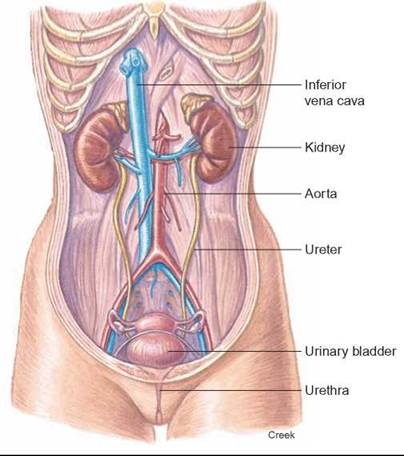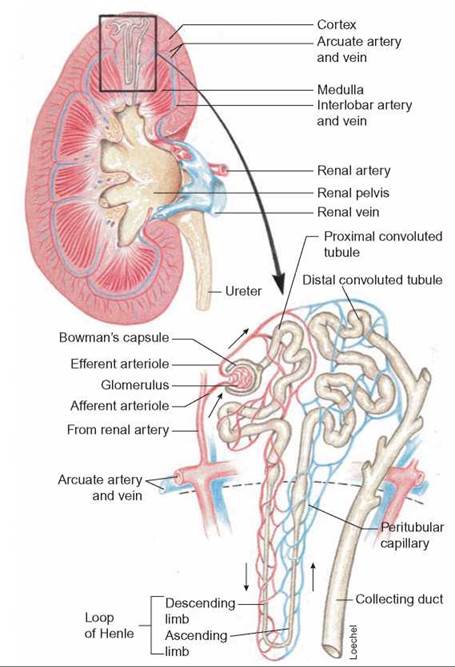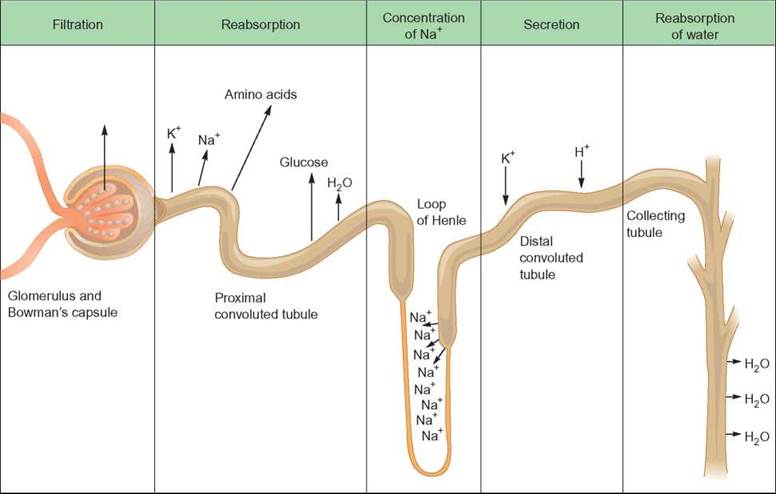CONCEPTS IN BIOLOGY
PART VI. PHYSIOLOGICAL PROCESSES
24. Materials Exchange in the Body
24.6. Waste Disposal: The Excretory System
The excretory system is the organ system responsible for the processing and elimination of metabolic waste products; it consists of the kidneys, ureters, urinary bladder, and urethra (figure 24.12). Because cells modify molecules during metabolic processes, harmful waste products are constantly being formed. Urea is a common waste; many other toxic materials must be eliminated as well. Among these are large numbers of hydrogen ions produced by metabolism. This excess of hydrogen ions must be removed from the bloodstream. Other molecules, such as water and salts, may be consumed in excessive amounts and must also be removed.

FIGURE 24.12. The Excretory System
The primary organs involved in removing materials from the blood are the kidneys. The urine produced by the kidneys is transported by the ureters to the urinary bladder. From the bladder, the urine is emptied to the outside of the body by way of the urethra.
Kidney Structure
The kidneys are the primary organs involved in regulating the level of toxic or unnecessary molecules in the body. The kidneys consist of about 2.4 million tiny units called nephrons. At one end of a nephron is a cup-shaped structure called a Bowman’s capsule, which surrounds a knot of capillaries known as a glomerulus (figure 24.13). In addition to Bowman’s capsule, a nephron consists of three distinctly different regions: the proximal convoluted tubule, the loop of Henle, and the distal convoluted tubule. The distal convoluted tubule of a nephron is connected to a collecting duct, which transports fluid to the ureters and ultimately to the urinary bladder, where it is stored until it can be eliminated through the urethra.

FIGURE 24.13. The Structure of the Nephron
The nephron and the closely associated blood vessels create a system that allows for the passage of materials from the circulatory system to the nephron by way of the glomerulus and Bowman’s capsule. Materials are added to and removed from the fluid in the nephron via the tubular portions of the nephron and their associated capillaries.
Kidney Function
As in the other systems discussed in this chapter, the excretory system involves a close connection between the circulatory system and a surface. In this case, the large surface is provided by the walls of the millions of nephrons, which are surrounded by capillaries. Three major activities occur at these surfaces: filtration, reabsorption, and secretion. The glomerulus presents a large surface for the filtering of material from the blood to Bowman’s capsule. Blood that enters the glomerulus is under pressure from the muscular contraction of the heart. The capillaries of the glomerulus are quite porous and provide a large surface area for the movement of water and small dissolved molecules from the blood into Bowman’s capsule. Normally, only the smaller molecules, such as glucose, amino acids, and ions, are able to pass through the glomerulus into the Bowman’s capsule at the end of the nephron. The various kinds of blood cells and larger molecules, such as proteins like albumin, do not pass out of the blood into the nephron. (The chronic presence of albumin in the urine is an indicator of kidney damage or disease.) This physical filtration process allows many kinds of molecules to leave the blood and enter the nephron. The volume of material filtered in this way through the approximately 2.4 million nephrons of the kidneys is about 7.5 liters per hour. Because the entire blood supply is about 5 to 6 liters, there must be a method for recovering much of this fluid.
Surrounding the various portions of the nephron are capillaries that passively accept or release molecules on the basis of diffusion gradients. The walls of the nephron are made of cells that actively assist in the transport of materials. Some molecules are reabsorbed from the nephron and picked up by the capillaries that surround them, whereas other molecules are actively secreted into the nephron from the capillaries. Each portion of the nephron has cells with specific secretory abilities.
The proximal convoluted tubule is primarily responsible for reabsorbing valuable materials from the fluid moving through it. Molecules such as glucose, amino acids, and sodium ions are actively transported across the membrane of the proximal convoluted tubule and returned to the blood. In addition, water moves across the membrane because it follows the absorbed molecules and diffuses to the area where water molecules are less common. By the time the fluid has reached the end of the proximal convoluted tubule, about 65% of the fluid has been reabsorbed into the capillaries surrounding this region.
The next portion of the tubule, the loop of Henle, is primarily involved in removing additional water from the nephron. Although the details of the mechanism are complicated, the principles are rather simple. The cells of the ascending loop of Henle actively transport sodium ions from the nephron into the space between nephrons where sodium ions accumulate in the fluid that surrounds the loop of Henle. The collecting ducts pass through this region as they carry urine to the ureters. Because the area these collecting ducts pass through is high in sodium ions, water within the collecting ducts diffuses from the ducts and is picked up by surrounding capillaries. However, the ability of water to pass through the wall of the collecting duct is regulated by hormones. Thus, it is possible to control water loss from the body by regulating the amount of water lost from the collecting ducts. For example, if you drank a liter of water or some other liquid, the excess water would not be allowed to leave the collecting duct (it would stay in the collecting duct) and would exit the body as part of the urine. However, if you were dehydrated, most of the water passing through the collecting ducts would be reabsorbed, and very little urine would be produced. The primary hormone involved in regulating water loss is the antidiuretic hormone (ADH). When the body has excess water, cells in the hypothalamus of the brain respond and send a signal to the pituitary, and only a small amount of ADH is released and water is lost in the urine. When you are dehydrated, the same brain cells cause more ADH to be released and water leaves the collecting duct and is returned to the blood.
The distal convoluted tubule is primarily involved in fine- tuning the amounts of various kinds of molecules that are lost in the urine. Hydrogen ions (H+), sodium ions (Na+), chloride ions (Cl-), potassium ions (K+), and ammonium ions (NH4+) are regulated in this way. Some molecules that pass through the nephron are relatively unaffected by the various activities going on in the kidneys. One of these is urea, which is filtered through the glomerulus into Bowman’s capsule. As it passes through the nephron, much of it stays in the tubule and is eliminated in the urine. Many other kinds of molecules, such as minor metabolic waste products and some drugs, are also treated in this manner. Figure 24.14 summarizes the major functions of the various portions of the kidney tubule system.

FIGURE 24.14. Specific Functions of the Nephron
Each portion of the nephron has specific functions. The glomerulus and Bowman’s capsule accomplish the filtration of fluid from the bloodstream into the nephron. The proximal convoluted tubule reabsorbs most of the material filtered. The loop of Henle concentrates Na+ so that water will move from the collecting tubule. The distal convoluted tubule regulates pH and ion concentration by differential secretion of K+ and H+ and other ions.
24.6. CONCEPT REVIEW
15. What are the functions of the glomerulus, proximal convoluted tubule, loop of Henle, and distal convoluted tubule?
16. Describe how the kidneys regulate the amount of water in the body.
Summary
The body’s systems must be integrated in such a way that the internal environment stays relatively constant. This chapter surveys five systems of the body—the cardiovascular, lymphatic, respiratory, digestive, and excretory systems—and describes how they are integrated. All of these systems are involved in the exchange of materials across membranes.
The cardiovascular system consists of a pump, the heart, and blood vessels that distribute the blood to all parts of the body. The blood is a carrier fluid that transports molecules and heat. The exchange of materials between the blood and body cells takes place through the walls of the capillaries. Because the flow of blood can be regulated by the contraction of arterioles, blood can be sent to different parts of the body at different times. Hemoglobin in red blood cells is very important in the transport of oxygen. Carbonic anhydrase is an enzyme in red blood cells that converts carbon dioxide into bicarbonate ions, which can be easily carried by the blood.
The lymphatic system is a collection of thin-walled tubes (lymph vessels) that branch throughout the body and lymph organs. The lymphatic system moves fat from the intestinal tract to the bloodstream through lacteals, transports excess tissue fluid back to the cardiovascular system, and defends against harmful agents, such as bacteria and viruses. The lymph organs include the lymph nodes, tonsils, spleen, thymus gland, and red bone marrow.
The respiratory system consists of the lungs and the associated tubes that allow air to enter and leave the lungs. The diaphragm and muscles of the chest wall are important in the process of breathing. In the lungs, alveoli provide a large surface area in association with capillaries, which allows for the rapid exchange of oxygen and carbon dioxide.
The digestive system disassembles food molecules. This involves several processes: grinding by the teeth and stomach, the emulsification of fats by bile from the liver, the addition of water to dissolve molecules, and enzymatic action to break complex molecules into simpler molecules for absorption. The small intestine provides a large surface area for the absorption of nutrients, because it is long and its wall contains many tiny projections that increase surface area. Once absorbed, the materials are carried to the liver, where molecules can be modified. The large intestine is primarily involved in reabsorption of water.
The excretory system is a filtering system of the body. The kidneys consist of nephrons, into which the circulatory system filters fluid. Most of this fluid is useful and is reclaimed by the cells that make up the walls of these tubules. Materials that are present in excess and those that are harmful are allowed to escape. Some molecules may be secreted into the tubules before being eliminated from the body.
Basic Review
1. The vessels that carry blood away from the heart are
a. veins.
b. arteries.
c. capillaries.
d. lacteals.
2. Which of the following is not a formed element?
a. rbc
b. wbc
c. platelets
d. plasma
3. _____ is the liquid that baths the body’s cells and contains the same chemicals as plasma but smaller amounts of albumin.
4. Which of the following is not a function of the lymphatic system?
a. It moves fat from the intestinal tract to the bloodstream.
b. It transports excess tissue fluid back to the cardiovascular system.
c. It defends against harmful agents, such as bacteria and viruses.
d. It carries oxygen to cells deep in the body.
5. The stomach
a. produces hydrochloric acid.
b. begins digestion of protein.
c. continues the mechanical breakdown of food begun in the mouth.
d. All of the above are correct.
6. Saliva contains the enzyme _____, which begins the chemical breakdown of starch.
a. salivary amylase
b. pepsin
c. trypsin
d. pylorase
7. In the respiratory system, the small sacs in the lungs where gas exchange takes place are called
a. nephrons.
b. alveoli.
c. nodes.
d. platelets.
8. The lining of the small intestine consists of millions of fingerlike projections, called
a. nodes.
b. alveoli.
c. villi.
d. glomeruli.
9. The proximal convoluted tubule is primarily involved in
a. secreting harmful materials into the nephron.
b. reabsorbing useful materials from the nephron.
c. removing hydrogen ions from the urine.
d. None of the above is correct.
10. About 200 billion _____ are formed each day and are important in blood clotting.
a. nephrons
b. lacteals
c. platelets
d. formed elements
11. The primary waste products released in the urine are _____ and _____.
12. The flow of blood back to the heart through veins is assisted by valves and _____.
13. Breathing rate is primarily determined by the level of the chemical _____ in the blood.
14. Capillaries are intimately associated with the _____ of the lungs, the _____ of the kidneys, and the _____ of the small intestine.
15. The right ventricle pumps blood to the _____.
Answers
1. b 2. d 3. Tissue fluid 4. d 5. d 6. a 7. b 8. c 9. b 10. c 11. urea; hydrogen ions 12. contractions of the body’s muscles 13. carbon dioxide 14. alveoli, nephrons, villi 15. Lungs
Thinking Critically
Mechanically Assisted Life
It is possible to keep a human being alive even if the heart, lungs, kidneys, and digestive tract are not functioning by using heart-lung machines in conjunction with kidney dialysis and intravenous feeding. This implies that the basic physical principles involved in the functioning of these systems is well understood because the natural functions can be duplicated with mechanical devices. However, these machines are expensive and require considerable maintenance. Should society be spending money to develop smaller, more efficient mechanisms that could be used to replace diseased or damaged hearts, lungs, and kidneys?